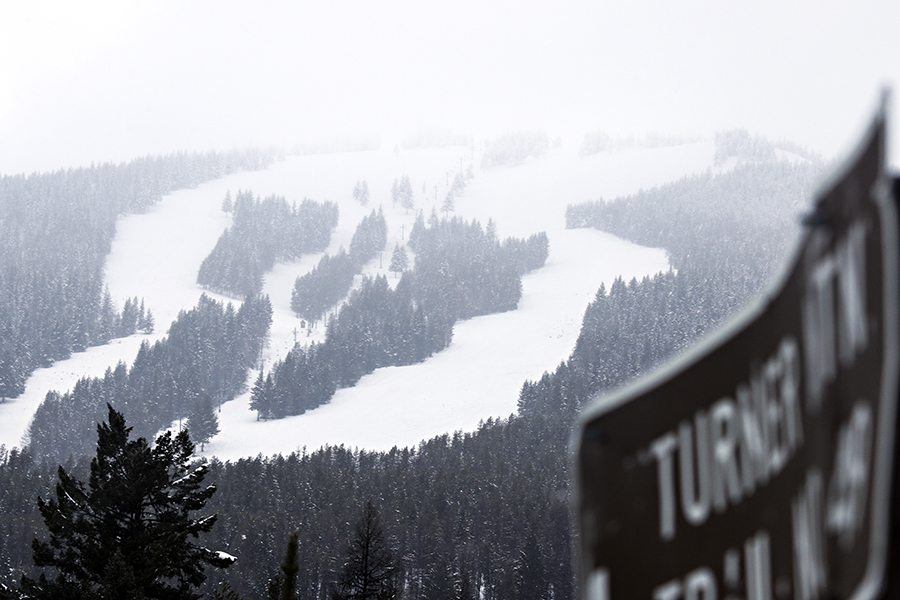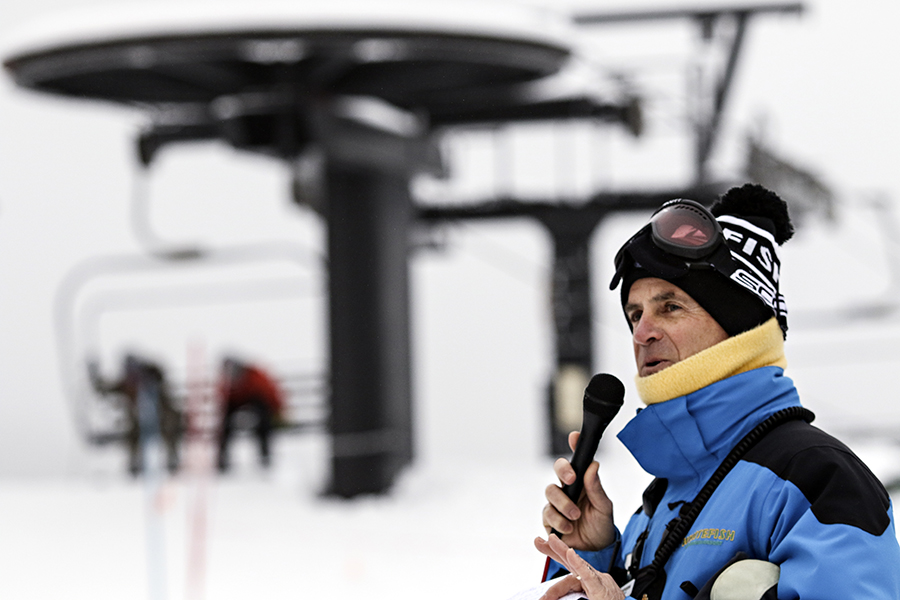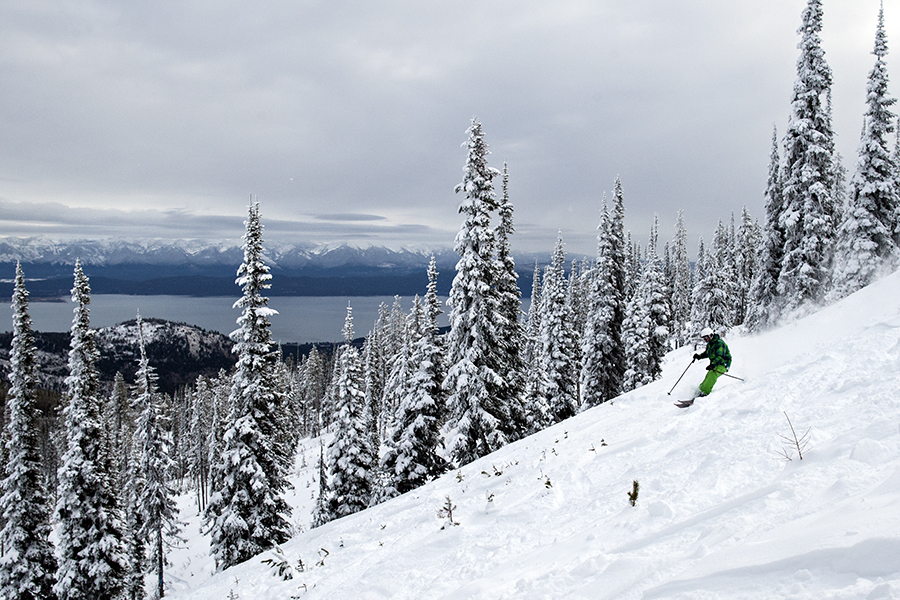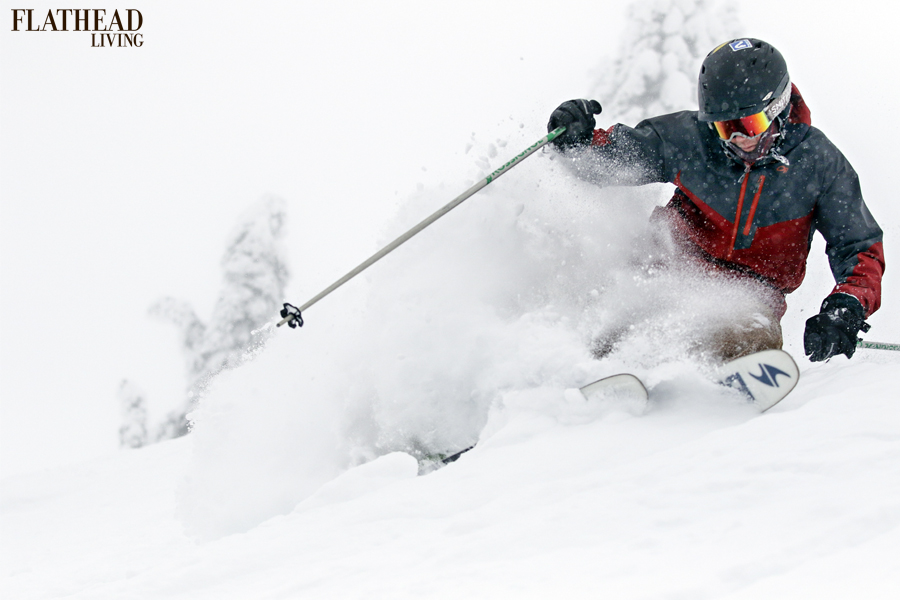The young skier dressed in a black mesh shirt ties a black bandana around his forehead and pulls a goofy face for the camera. His friends, dressed up in Hawaiian shirts, cheer. Others smile on, chatting and holding dark beers while waiting in the queue for a Whitefish Mountain Resort season pass sale event hosted by the Great Northern Brewery this fall.
“This is the best day of the year — second best, after opening day,” one passholder says.
Over the years, skiers and snowboarders collect these plastic rectangles like scout badges, saving them as mementos of good times and worse hairstyles. For many locals, they’re tokens of commitment to the home hill.
The biggest ski companies in America are growing through the acquisition and homogenization of independently owned resorts, small and large. This well-established trend has escalated, in recent years, into an arms race to dominate regional markets. The empire-building, bottom-line-driven approach of resort group titans has resulted in the accelerated development and commodification of mountain valleys, in some cases to the detriment of human and natural communities. But there are exceptions. Northwest Montana is one of few remaining regions in American snow states where a conglomerate giant hasn’t taken up residence. Turner Mountain Ski Area, in Libby, is owned by a nonprofit foundation and operated almost entirely by volunteers. Whitefish Mountain Resort is owned and operated by the corporation that founded the mountain, and whose largest shareholder is a billionaire businessman with local ties. Blacktail Mountain resort, in Lakeside, is still owned by its four founders, who are seeking a successor.
Many skiers love multi-destination passes, like Vail’s EPIC and Alterra’s Ikon, which open up wonderful travel opportunities for those who are able to take advantage of them. As with Vail’s Afton Alps, located on the outskirts of Minneapolis, conglomerate investment promises to keep mom-and-pop ski areas alive and introduce skiing to more folks living in urban areas. But a balanced mountain town culture requires meaningful agency of locals in its resorts. Outsized outside investment often creates dramatic wealth disparity in rural mountain towns, exacerbating the proliferation of second- and third-homes, and eventually pushing out lower-income workers, including those who prioritize skiing above all else. This displacement, compounded by the corporate effort to create a more streamlined experience across its properties, can undermine the idiosyncratic character that originally made the ski town special.
Due to the significant costs of running a winter resort, especially in a densely consolidating industry, many ski areas haven’t been able to stay open under independent ownership, either shutting down or selling out. But the chairlifts at Turner, Whitefish, and Blacktail are still spinning. Overdevelopment has never been a concern for Turner or Blacktail; growth at Whitefish has been more ambitious, but by national standards, it’s still rootsy and unpretentious for a resort of its size.
There’s no guarantee that independent ownership will continue to be successful here, but the skiers and snowboarders who smile for a pass photo in Northwest Montana do so knowing that they’re paying to recreate someplace built and sustained by local interests and investment.

Turner Mountain Ski Area
Base elevation: 3,842
Summit elevation: 5,952
Annual skier visits 2017/2018: 4,600
Cost: An adult day pass is $38, an adult season pass is $495, and a four-person family pass is $1,285
Volunteers opened Turner Ski Area in 1961, about 20 miles north of Libby inside the Kootenai National Forest. Located in a remote corner of the state, it’s more reliant on its community of locals than most ski areas. But a formidable volunteer ethic is embedded in Libby, and its supporters have been able to keep the mountain open every single winter since it opened. The people who live here understand that if they don’t contribute, in whatever way they’re able, they will lose Turner.
For decades, the longest T-Bar in North America hauled skiers 2,100 feet straight up Turner’s fall line. When passholders joked that going up was harder than going down, they weren’t really joking. But chairlifts are expensive. By the mid-1990s, the T-Bar had aged beyond reliability, and the community rallied behind Kootenai Winter Sports Inc., the nonprofit that owns the hill, to raise enough money to purchase used chairlift materials. Licensed engineers, electricians, and experts in other journeymen trades donated their expertise to refurbish and install the lift, which opened in January 2002. Three years later, volunteers built a new lodge, replacing a primitive warming shack. In December 2014, a catastrophic fire ravaged the equipment workshop, destroying many critical tools, and the mountain still opened two weeks later.
“We didn’t skip a beat. We survived that. That goes to show you what this community is capable of,” Bruce Zwang, Turner’s board of directors president, says. “If you roll up your sleeves and get to work up there, you’re going to feel a sense of ownership and a sense of pride. You helped keep the dream alive.”
All this time, Turner has been the quietest surviving ski area in Montana, in terms of skier visits. And though it has grown since the ‘60s, it hasn’t grown a lot. All services — lift tickets, patrol, rentals, and the modest cafeteria — are under one roof. Après-ski revelers congregate in the small parking lot. Everything runs on a generator. If you call the main number, the phone rings in Zwang’s office in Libby, where he works as an accountant.
Aside from the December holidays and President’s Day, Turner is open only on Friday, Saturday, and Sunday. At least 50 people contribute enough volunteer hours to earn a pass; the only two paid employees are lift operation and maintenance. Midweek private rentals that cost $3,750, a 20-year-tradition, help keep Turner in the black. Mountain manager Jon Jeresek says they’ve never missed a payment on long-term loans, and that “very dedicated financial supporters” will sometimes call up and see if the ski area could use a big check. For the people who ski Turner, this effort is, without question, worth the sacrifices that sustain the business.
“What I see people appreciating the most about Turner,” Jersek says, “is just the absolute freedom and relaxation with the experience. Skiing at Turner is one of the most relaxing ski experiences you can ever imagine … This is an experience that was fairly common in the Mountain West. It’s faded, with small areas going under, and big areas surviving, and big areas becoming a destination catering to regional or out-of-region skiers. Ours is not that. We are not that.”
At Turner, it’s often quiet in the lodge. People here like that. They don’t worry about losing friends. They don’t worry about skiing fast enough, or in the right places, to get the good snow before it’s skied out. They see wildlife — all the time. (Jeresek says he’s observed wolverine and mountain lions.) At 9 a.m. on a Saturday, they park a few hundred feet from the chairlift. Lap after lap, they ski through evenly spaced glades with high-limbed trees, down 2,100 feet of fall line slopes with a consistent pitch. At 3:59 p.m. on a powder day, they spot un-skied lines from the slow double chair. Turner evokes the joy of skiing in a place where a community’s dedication alone has preserved the leisure and pleasure of this completely nonessential, but absolutely blissful, pastime for almost 60 years.
“Survival? I’ve never been concerned about our survival,” Zwang says. “We’ll do what’s necessary to keep going. We always have. We always will.”

Whitefish Mountain Resort
Base elevation: 4,464 ft.
Summit elevation: 6,817 ft.
Annual skier visits 2017/2018: 382,066
Cost: An adult season pass, which offers 18 days at partner ski resorts like Great Divide and Red Lodge, is $660 if purchased pre-season. A lift ticket is $81 at the window; it’s cheaper if you buy it in advance online, or at Costco.
Whitefish’s pioneering skiers, Lloyd “Mully” Muldown and Ole Dalen, marked the first descent on the Big Mountain in 1933, a generation after the town of Whitefish’s founding, and two years before Sun Valley, America’s first “destination” ski resort, opened in Idaho. Many skiers in the Hell-Roaring Ski Club, which formed in 1937, were enthusiastic about the prospect of growth. Their aspirations for winter tourism in this railroad town reached far beyond anything that Montana’s quaint ski areas had ever seen.
“There was a vision of what could happen there,” says Mike Muldown, Mully’s son and a Whitefish real estate agent. “[Sun Valley] was the icon. And when they tried to advocate for Whitefish becoming at least something like that, they were a little unrealistic in their expectations. They were on a shoestring budget.”
In March 1947, the winter before opening day, Winter Sports Inc. (WSI) — the corporation that still owns and operates the resort — formed, with $70,000 in stock authorized. Whitefish locals financed more than half of the startup investment; the rest came from Ed Schenck and George Prentice, Great Falls businessmen who moved to the area to help start the resort. Eight months into the first year of operations on the Big Mountain, Schenck reportedly declared the project “dead broke,” according to Jean Arthur’s book “Hellroaring.”
Supporters locked the doors on a community meeting until attendees ponied up an additional $6,000 in donations. Rusty Abel, the founder of Whitefish Credit Union, loaned skiers money at no interest so they could buy more stock. Resort employees accepted stocks instead of paychecks, and businesses, like Nelson’s Hardware, accepted stocks instead of cash. Schenck’s descendants have said that his personal finances suffered because of how hard he worked up there, frequently without compensation.
Only two years after the ski area opened, Whitefish hosted the National Ski Association Championships. This was the biggest ski-racing event in the country. Whitefish didn’t even have a chairlift. But the event was a success. Whitefish continued to host ski races, producing talented athletes, which kept the community in the news. Trains filled with families from the Midwest and Seattle rolled into town every week. It was a lively scene up on the mountain, day and night. As more people relocated to experience the frontier of skiing in the northern American Rockies, the rail town began its transformation into a ski town. A ski culture grew, shaped by the region’s seclusion, often-harsh weather conditions, and glorious powder days.
By the late ‘50s, “it had pretty well been figured out that one T-Bar, one Poma Lift, and one rope tow were not just going to hack it if The Big Mountain was ever going to become a real destination ski resort,” Norm Kurtz wrote in his memoir “Chair One.” Originally a Whitefish ski bum, Kurtz was promoted through the ranks to general manager in the late ‘70s. According to Kurtz, two stockholders loaned the money to buy a lift that would reach the top of the mountain. When Chair 1 was installed in 1960, Kurtz says, “it was euphoria up on the hill!”
In the ‘70s, local families who purchased WSI stock finally saw a return on their initial investment. The next growth push was to expand mountain facilities and on-hill bed capacity. First came two subdivisions, and then the Alpenglow, which was Montana’s first recreational condominium. In the early ‘80s, WSI began selling parcels of base area real estate via The Big Mountain Development Corporation. In the ‘90s, Mike Collins, a ski resort developer, was hired as the CEO, and he installed Whitefish’s first high-speed chair and a snowmaking system, undergrounded power in the village, and began arranging direct flights from Minneapolis. “I wanted to be a competitive resort in the Northwest,” Collins says. He says there was never enough funding to build a hotel, and though he courted hoteliers, they expressed more interest in downtown opportunities. What was attainable was building duplex, townhome, and single-family home developments.
The board of directors’ majority, which was full of longtime Whitefish locals, approved all this growth. But some board and community members worried that it distracted from the resort’s core competency. Real estate investments helped the business weather some difficult seasons, but by the turn of the century, the resort was mired in debt.
In 2004, and then again in 2006, the board of directors voted to reduce the number of WSI shares through reverse-stock splits, buying out investors with smaller amounts of stock. On the Big Mountain’s 50th anniversary, in 1997, WSI had more than 800 stockholders. After the reverse-stock splits, only a few dozen remained. Bill Foley, an independently wealthy, non-skiing investor, held the majority share.

Fred Jones, who replaced Collins as CEO of WSI, explained that the reverse-stock split was needed to make the Big Mountain’s operating model more tax-efficient. But skiers felt blindsided and betrayed. In 1950, Schenck had told the Evening Post that, through collaboration, the Big Mountain had “become a concrete expression of the town’s spirit of adventure and cooperation.” The reverse-stock split buried this history of grassroots, generational support.
Foley changed the name to Whitefish Mountain Resort (WMR) the following year, which did not endear him to spurned locals. Diehards still call it the Big. But Foley began loaning the resort funds for major on-mountain improvements. Just before the 2008 recession, Foley and Dan Graves, the CFO hired by Jones, refocused on making operations profitable — without relying on real estate. Under Foley’s leadership, Whitefish has seen chairlift upgrades and the instillation of beloved new lifts, the Summit House expansion, and significant development of summer operations, including downhill mountain biking.
This fall, WMR sold a record-breaking 10,000 season passes. Since 2006, the resort has seen an overall growth trend in skier visits. The readers of SKI magazine recently voted Whitefish #1 in the west for “Overall Satisfaction.” (The past two seasons, while other regions struggled with snowfall, Whitefish received more than 400 inches, which hasn’t hurt.) Foley and Graves “went from being demonized to being our savior,” Kent Gilkerson, a 30-year Whitefish passholder, says. Muldown believes the founders would be pleased with how the ski area has evolved, with the exception of losing local shareholders.
“A ski area that values its locals, that’s what makes a healthy and vibrant skiing community,” says John Davies, a former POWDER magazine editor who has been visiting his brother in Whitefish for 20 years. “The trick with ski areas is to change the place without really changing the place. You have to keep the lights on, improve infrastructure, and protect the identity. That manifests in local pride. There’s a lot of that in Whitefish.”
There’s no official platform for local input, such as an advisory council of passholders, but Graves, the former CFO who is now CEO, says he gladly listens to skiers with feedback on operations. The resort also regularly processes customer surveys, and many big decisions, like the proposed Hellroaring Basin expansion, are open to public comment because WMR is partially on U.S. Forest Service lands.
For his part, Graves says big resort conglomerates occasionally call, but he “would prefer the resort to be owned independently by a small group of investors with interest in the resort and community vs. a large, distant conglomerate.”
“Certainly, our largest shareholder, Mr. Foley, doesn’t want to jeopardize the way the community feels about this resort, related to an ownership change,” Graves added.
There’s a reason the rumor that Foley plans to sell out never dies. This gossip reflects classic mountain town anxieties about cost of living and overdevelopment. More than that, it expresses the protectiveness and kinship that Whitefish’s skiers and snowboarders feel for what is still their beloved home hill.

Blacktail Mountain Ski Area
Base elevation: 5,340
Summit elevation: 6,780
Annual skier visits 2017/2018: 44,260
Cost: A day ticket is $42, and an adult season pass costs $395.
While Steve Spencer worked as mountain manager on the Big Mountain in Whitefish in the ‘90s, he grew increasingly uncomfortable with its trajectory. The Columbia Falls-born skier wanted a return to the regional ski area model that catered to local families, no bells or whistles. So he recruited Flathead Valley contractors he knew from the Big Mountain — Tom Sands, a surveyor; Dennis Carver, a civil engineer; and Jeff Sorg, a carpenter — and set his sights on the Island Unit of the Flathead National Forest, overlooking Flathead Lake.
They paid a local research firm to assess consumer interest. “It came out so positive, we didn’t believe it, so we did it again,” Spencer says. He consulted wildlife and conservation environmental groups, who were supportive of recreational development in the isolated district. A snow study performed by the Forest Service in the late ‘60s had already demonstrated reliable annual snowfall.
Their proposal was so solid that the Forest Service issued its first Special Use Permit for ski resort development since 1987 — it has not issued one since. The founders poured sweat equity into the place. Spencer drew the ski runs, Carver designed the sewer and water systems, Sands profiled the topography for lift placement, and Sorg built resort facilities. After opening in December 1988, it took about a decade of financial uncertainty for Blacktail to find its groove.
“We operate on a tight budget,” Spencer says. “If it’s got any risk to it, we don’t think about it. It pays for itself, it’s not a burden … The whole time, it’s been word of mouth, which is a healthy way to grow. It wasn’t a fast growth. It wasn’t a dishonest growth. It wasn’t an unrealistic growth. People come here, and if we get them once, we get them back.”
Skiers are often surprised by Blacktail’s size, he says. “From the airport, or from Bigfork, you only see the top third of the big lift.” It’s situated almost entirely on north-facing slopes, where snow is better preserved. Because the mountain is not open on Mondays or Tuesdays, so-called “powder Wednesdays” can be deep. The weather patterns are different from Whitefish; you’ll never see a snow ghost, those rime-encrusted tree formations caused by persistent fog coverage. Skiers expect more sunny days, and terrific vistas of the Mission and Cabinet Mountains, Flathead Lake, and Glacier National Park. Passholders at Blacktail are also vocal about how highly they value local ownership.
“What I see happening at Big Mountain is offensive to me,” says Diane Edge, a Bigfork-based Blacktail skier who used to buy a Whitefish pass, too. She doesn’t like the crowds, and she’s nostalgic about uncommercialized skiing experiences. The Blacktail owners, she believes, “give a damn … They don’t just own it; they love it.”
In 2002, Spencer and his three partners listed Blacktail for sale, but they didn’t receive any offers. They’re not rushing to unload the property — just ready for retirement, sometime soon. They re-listed it in May of this year, asking $3.5 million for the turnkey operation, including three chairlifts and a 17,000-square-foot base lodge.

Blacktail is unlikely to appeal to conglomerates, which typically acquire smaller ski areas only when they are easily accessed by a major metropolis. An outside buyer could support local interests, like Foley has at Whitefish. Because Blacktail, including its base area, is located entirely on Forest Service land, the federal agency will have to approve the buyer, and private commercial and real estate developments will never be permitted. The downhome character that Blacktail passholders love is secure. Through a realtor, Spencer has fielded interest from prospective buyers in China, Australia, England, Canada, New York, and the American West.
“The ideal buyer would not be an individual, but a consortium of individuals,” says Gordon Phillips, a Blacktail skier since day one, who also buys a Whitefish pass.
Other passholders, like Bill Metzler, have expressed interest in pooling resources to buy the property. A lifelong Lakeside resident, Metzler skied on this mountain before the resort was founded, and he’s specified in his will that his ashes be spread up there. He respects community-based ownership models that have been successful at Bridger Bowl, in Bozeman, and Red Mountain, in interior British Columbia, less than five hours from Kalispell. Because Bridger and Red are renowned for their challenging terrain, they’ve easily attracted skier support from near and far. Metzler says he’d be in “total favor” of a grassroots option, even if it involves some outside investment.
The history of Northwest Montana skiing shows that the immense challenge of maintaining, or growing, an independent ski business extends beyond luck or good snowfall or even business savvy. A healthy ski area takes care of its locals, regardless of how much it depends on tourism dollars. By operating in a way that reflects local pride and passion, Turner, Whitefish, and Blacktail continue to receive community support and investment. This tight-knit, reciprocal spirit is keeping Northwest Montana ski areas alive, and thriving.
